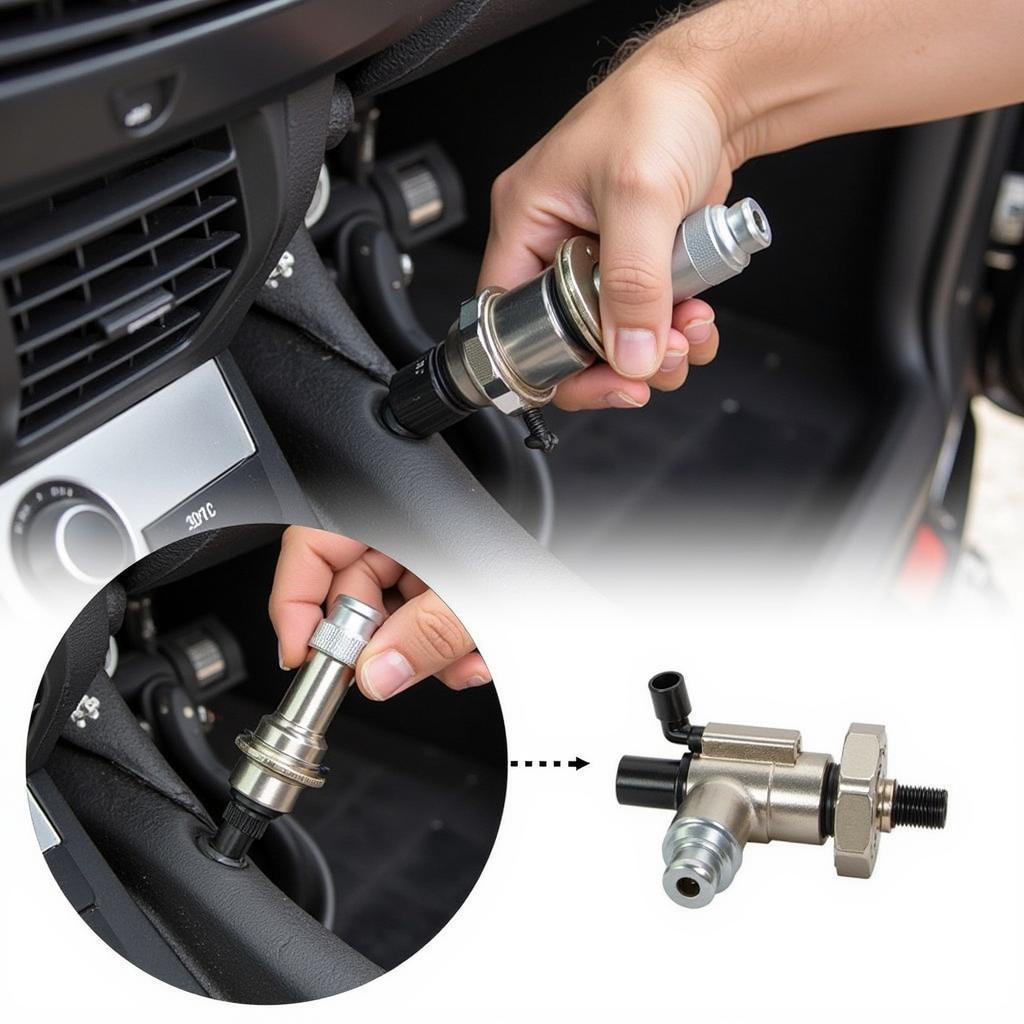A flooded evaporator can lead to a variety of problems in your car’s AC system, from reduced cooling performance to unpleasant odors. This article will guide you through the causes, diagnosis, and solutions for how to fix a flooded evaporator in your car, empowering you to troubleshoot and potentially resolve this issue yourself.
Understanding Your Car’s AC System and Evaporator Problems
The evaporator is a crucial component of your car’s air conditioning system. It’s responsible for absorbing heat from the air blown into the cabin, effectively cooling it down. When this component malfunctions, especially when it gets “flooded,” it can significantly impact the comfort and functionality of your vehicle’s AC.
What is a Flooded Evaporator?
A “flooded evaporator” refers to a situation where liquid refrigerant, instead of vapor, reaches and accumulates in the evaporator. This can happen due to a variety of reasons, which we will discuss in detail later. This malfunction disrupts the normal heat exchange process and can lead to several noticeable problems.
Common Signs of a Flooded Evaporator
- Reduced Cooling: One of the most obvious signs is a decrease in the effectiveness of your AC. The air blowing out might be less cold than usual.
- Strange Noises: Gurgling or hissing sounds from the AC vents can indicate refrigerant flooding.
- Water Leaks: You might notice water dripping inside the cabin, usually near the dashboard, as excess moisture condenses around the flooded evaporator.
- Foul Odors: A musty or mildew-like smell can develop due to the accumulation of moisture, which creates a breeding ground for bacteria and mold.
 Flooded Car Evaporator Symptoms
Flooded Car Evaporator Symptoms
Diagnosing a Flooded Evaporator
Before attempting any repairs, it’s crucial to confirm that a flooded evaporator is indeed the culprit. Here’s a simple checklist:
- Check Refrigerant Levels: Low refrigerant levels can sometimes mimic the symptoms of a flooded evaporator. Have a qualified technician check the refrigerant charge using appropriate gauges.
- Inspect the AC Drain: A clogged AC drain line can prevent condensation from escaping, leading to symptoms similar to a flooded evaporator. Locate the drain line under your car and ensure it’s clear.
- Observe the Evaporator: In some cases, you might be able to visually inspect the evaporator (often located behind the glove compartment) for signs of icing or excessive moisture.
 Car AC Drain Line Inspection
Car AC Drain Line Inspection
How to Fix a Flooded Evaporator: Step-by-Step Guide
Fixing a flooded evaporator often requires professional assistance. However, addressing some underlying causes can be done DIY-style:
- Clear a Clogged Drain Line: Use compressed air or a thin wire to remove debris blocking the drain line. This is a common cause of evaporator flooding and can be relatively easy to fix.
- Check the Expansion Valve: A faulty expansion valve can cause liquid refrigerant to enter the evaporator. Replacing this valve usually requires a technician.
- Address Refrigerant Leaks: Leaks in the AC system can lead to low refrigerant levels and, consequently, a flooded evaporator. Leak detection and repair should be performed by a certified professional.
- Professional Cleaning or Replacement: If the evaporator itself is damaged or excessively contaminated, professional cleaning or replacement may be necessary.
 Replacing Car AC Expansion Valve
Replacing Car AC Expansion Valve
“Regular maintenance is key,” says John Miller, Senior Automotive Technician at Miller’s Auto Repair. “Checking your AC system annually can prevent many issues, including a flooded evaporator, before they become major problems.”
Preventing Future Evaporator Issues
Preventing a flooded evaporator involves regular maintenance and addressing potential problems promptly:
- Annual AC Service: Have your AC system inspected and serviced yearly by a qualified technician.
- Regularly Check the Drain Line: Periodically inspect and clean the AC drain line to prevent clogs.
- Address AC Issues Promptly: Don’t ignore any signs of AC malfunction, such as reduced cooling or unusual noises.
“Addressing small issues early can save you a lot of money and hassle down the road,” adds Sarah Johnson, Lead HVAC Technician at Cool Breeze Auto Climate. “A simple check-up can prevent major repairs like evaporator replacement.”
Conclusion
A flooded evaporator can significantly impact your car’s AC performance. Understanding the causes, symptoms, and solutions can empower you to address this issue effectively. While some fixes can be DIY projects, more complex repairs often require professional assistance. Don’t hesitate to contact AutoTipPro at +1 (641) 206-8880 or visit our office at 500 N St Mary’s St, San Antonio, TX 78205, United States for expert help with your car’s AC system. Remember, preventative maintenance is always the best approach when it comes to how to fix a flooded evaporator in your car.
FAQ
- Can I drive with a flooded evaporator? While you can technically drive, it’s not recommended. Reduced cooling and potential water leaks can be distracting and uncomfortable.
- How much does it cost to fix a flooded evaporator? The cost varies depending on the cause and required repairs, ranging from a simple drain cleaning to a complete evaporator replacement.
- How long does it take to fix a flooded evaporator? The repair time depends on the complexity of the issue and can range from a few hours to a full day.
- Is a flooded evaporator covered under warranty? It depends on the specific warranty terms and the cause of the problem.
- Can a flooded evaporator damage other car parts? If left unaddressed, it can potentially damage other AC components or contribute to mold growth within the cabin.
- How often should I have my car’s AC serviced? Annual AC service is recommended to maintain optimal performance and prevent potential problems.
- Can I prevent a flooded evaporator by myself? Regular checks of the drain line and addressing any AC issues promptly can significantly reduce the risk of a flooded evaporator.





Leave a Reply